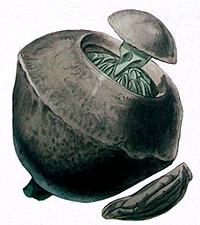
SAFARI
Users
Brazil Nut
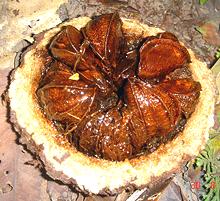 [Bertholletia excelsa]
[Bertholletia excelsa]
The Brazil nut tree, found in Brazil, Bolivia and Peru, is very large, growing to 160 feet tall and over 6-1/2 feet in diameter. The fruit may be from 4 to nearly 6 inches in diameter, and is very heavy, often weighing over 4 pounds. For this reason it is unwise to stand under a Brazil nut tree when the wind is blowing - getting hit by a 4 pound fruit falling more than 100 feet is not a pleasant experience, and may, in fact, be your last experience.
The Brazil nut tree fruits only in undisturbed forest, because it
depends on certain smelly wild orchids growing nearby to attract a
particular variety of large bumble bee, the only insect strong enough
to pry open the flowers and pollinate them. A single hard shelled fruit
may contain from 8 to 24 hard shelled "nuts" arranged like orange
wedges. The fruit matures in about 14 months after pollination. In nature
large squirrel-like rodents gnaw the pods open, eat some seeds and bury
others for future use - and just like our squirrels, they forget where
they hid them. Some of these sprout, but the sprouts may have to
wait many years for a large tree to fall so they have enough sunlight
to grow big.
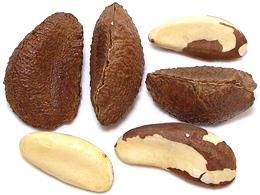 The Brazil nut has been much ballyhooed as a solution to rain forest
clearing - people can just gather the very profitable fruits from the
forest floor. Unfortunately this isn't working as a sustainable harvest.
Too many fruits are being gathered in many areas, and there aren't
enough young trees sprouting to sustain the forest.
The Brazil nut has been much ballyhooed as a solution to rain forest
clearing - people can just gather the very profitable fruits from the
forest floor. Unfortunately this isn't working as a sustainable harvest.
Too many fruits are being gathered in many areas, and there aren't
enough young trees sprouting to sustain the forest.
Brazil nut seeds are very nutritious, 18% protein, 13% carbohydrates
and 69% fats, with a large selection of vitamins and minerals. There are
also some downsides. Brazil nut seeds contain unusually high levels of
the anti-nutrient phytic acid, which suppresses uptake of some minerals,
particularly iron. Like other fruits in this family, it tends to
concentrate heavy metals, particularly selenium, and in this case
radium, in very small amounts, but about 1000 times more than in most
foods. The amount of selenium can be a health hazard if you overindulge,
resulting in hair loss and other symptoms. Europe has banned import of
Brazil nuts in the shell, as many shells have been found to be
contaminated with aflatoxins - so don't eat the shells. These seeds
are also a cause of allergic reactions in people with nut allergies,
even though they are technically not nuts.
Photo by Lior Golgher distributed under license Creative
Commons
Attribution-ShareAlike 3.0 Unported.
Anchovy Pear
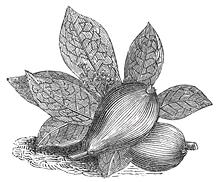 [Grias cauliflora]
[Grias cauliflora]
Native to Jamaica and other islands of the Caribbean, this tree, often
branchless, can grow to 50 feet tall, crowned with paddle shaped leaves
up to 3 feet long. Flowers, 2 inches across, sprout directly from the
trunk, as do the resulting fruit. The fruit, 2 to 3 inches long, looks
much like a brown kiwi fruit, but more pear shaped, and has a single
hard seed in the center. It is normally picked unripe, when it is quite
sour from it's vitamin C content, and is most often sliced and pickled
to be used as appetizers. The taste is similar to mango, which is
similarly pickled when unripe. This may have been developed by East
Indians who were brought in to work the plantations after all the native
Indians had been worked to death.
Drawing 1830 copyright expired.
Paradise Nut
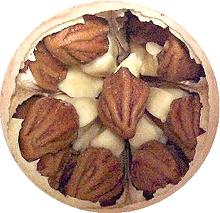 [Sapucaia; Lecythis zabucajo]
[Sapucaia; Lecythis zabucajo]
This large tree is native to Brazil, the Guianas, Suriname, Venezuela,
Ecuador and Honduras in tropical South America, and has been successfully
introduced to Trinidad. It's fruit pods are slightly flattened spheres
and may measure up to nearly 7 inches across. The woody shell is up
to 0.7 inches thick, and when the fruit is ripe, about a year after
flowering, the lid blows off (see illustration at top of page), allowing
access to the interior. Both the fruit arils (cream colored pulp) and the
seeds are edible. The seeds are reddish brown, roughly elliptical and up
to 1-1/2 inches long. They may be eaten raw or cooked, but in moderation.
They tend to absorb heavy metals, particularly selenium, in amounts that
could be harmful to health.
Photo by Nando cunha distributed under license Creative
Commons
Attribution-ShareAlike 3.0 Unported.
Cream Nut
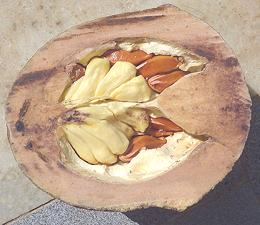 [Monkey Pot; Sapucaia, Castanha-de-sapucaia (Brazil); Lecythis
pisonis | Lecythis marcgraaviana (nearly
identical - former synonym)]
[Monkey Pot; Sapucaia, Castanha-de-sapucaia (Brazil); Lecythis
pisonis | Lecythis marcgraaviana (nearly
identical - former synonym)]
This tree is native to Brazil, the Guianas and Suriname in tropical
Eastern South America. It's fruit pods are roughly spherical or
ovoid, and may measure 3-1/2 inches to 11-1/2 across. The
woody shell is up to 1-1/2 inches thick, and when the fruit is ripe,
about a year after flowering, the lid blows off, allowing access to
the interior. Both the fruit arils (cream colored pulp) and the seeds
are edible. The seeds are reddish brown, roughly elliptical and up to 2
inches long. They may be eaten raw or cooked, but in moderation. They
tend to absorb heavy metals, particularly selenium, in amounts that
could be harmful to health.
Photo by Alex Popovkin distributed under license Creative Commons
Attribution-ShareAlike 3.0 Generic.
